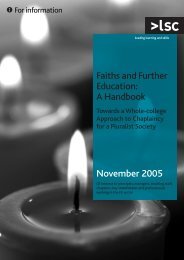The Bichard Inquiry - Report - Digital Education Resource Archive ...
The Bichard Inquiry - Report - Digital Education Resource Archive ...
The Bichard Inquiry - Report - Digital Education Resource Archive ...
Create successful ePaper yourself
Turn your PDF publications into a flip-book with our unique Google optimized e-Paper software.
3 <strong>The</strong> job of inputting information from Form 310 onto the PNC was the<br />
responsibility of the civilian staff in the Conviction Service Bureau, a part<br />
of each of the three Administration Support Units that serviced the four<br />
divisions of Humberside Police.<br />
4 Form 310 was also sent to the relevant Divisional Intelligence Bureaux (DIBx)<br />
– in each of the divisions of Humberside Police. <strong>The</strong> DIBx were staffed by a<br />
combination of police officers and civilian staff and were understood, at<br />
least by operational officers, to be responsible for inputting information and<br />
intelligence onto the local police intelligence system, CIS Nominals.<br />
5 When the ICJS was introduced, between 1995 and 1997, a copy of a<br />
charge prepared on it would automatically print out in the local Conviction<br />
Service Bureau. This would then be used immediately to create a skeleton<br />
PNC record. Later, the full arrest/summons report would be completed after<br />
receipt of Form 310, as explained above.<br />
6 Before November 1995, in common with other police forces, Humberside<br />
Police did not put any cautions for reportable offences onto the PNC,<br />
because the PNC program was not designed to allow this. Instead, they<br />
were recorded locally on CIS Nominals.<br />
7 After November 1995, such cautions could be put onto the PNC, but any<br />
issued before that date were not immediately put onto the system. In 1999<br />
Humberside Police implemented a back-record conversion programme<br />
for a limited number of offences, following liaison with the Home Office.<br />
(Police forces wishing to convert existing cautions were required first to<br />
liaise with the Home Office, due to a concern that a large-scale conversion<br />
exercise would cause a backlog at the National Fingerprint Office, as<br />
fingerprint records were required to confirm the identity of the subject of<br />
the electronic record.)<br />
8 It was the responsibility of the local police force that had created the<br />
records to review and delete them when appropriate, under data<br />
protection legislation.<br />
9 Humberside Police would conduct the review at the relevant time, in<br />
accordance with the Association of Chief Police Officers’ (ACPO) Code of<br />
Practice on Data Protection 1995 (called the 1995 ACPO Code).<br />
10 In May 1996, Humberside Police introduced a process by which certain<br />
cases (including those involving a court case where there had been an<br />
acquittal for unlawful sexual intercourse or other sex offences) would be<br />
reported to a supervisor so that a decision whether or not to keep a record<br />
on the PNC, in accordance with the 1995 ACPO Code, could be taken at<br />
superintendent level.<br />
<strong>The</strong> CIS<br />
11 <strong>The</strong> CIS was a local database, with two applications, operated by<br />
Humberside Police. In 1995, the system had been with the force for about<br />
ten years. It was designed as ‘an information-management and intelligence<br />
172 <strong>The</strong> <strong>Bichard</strong> <strong>Inquiry</strong> – Appendix 3
















